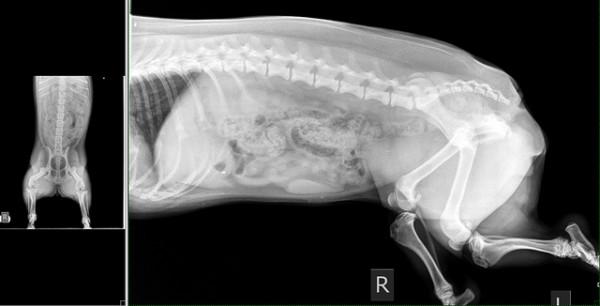
Rabbits can contract syphilis. Golden retrievers get breast cancer. Siamese cats and Doberman pinschers often have OCD–and are prescribed Prozac to ease their symptoms. Canaries, fish, and Yorkies react to stress by fainting. Humans and animals share all sorts of maladies, yet we insist on putting their treatment in silos: veterinarians deal with animals, MDs treat humans. But it wasn’t always this way, and it might not have to be in the future. In advance of “Should My Dog and I Share a Doctor?“, a Zócalo event, we asked veterinarians what their human counterparts can learn from them.
Listening, humility–and more about zoonotic diseases
 Having worked with numerous physicians, I am constantly impressed at what physicians know, and surprised at what they don’t know. There is little doubt that each profession has much to learn from each other and applying a One Health approach to each of our respective fields is the most beneficial way to practice medicine, regardless of the species.
Having worked with numerous physicians, I am constantly impressed at what physicians know, and surprised at what they don’t know. There is little doubt that each profession has much to learn from each other and applying a One Health approach to each of our respective fields is the most beneficial way to practice medicine, regardless of the species.
One of the most frustrating aspects of veterinary medicine is having a patient that cannot converse with you. They cannot tell you where they hurt or how they feel. Because of this, I believe veterinarians are more intuitive in evaluating their patients. Vets need to be able to read the subtle behavioral changes from each animal and deduce what is wrong with the patient based on this observation. We then use this information as part of the comprehensive, whole body examinations we are taught to perform regardless of the symptoms.
The strength of veterinary medicine is the holistic approach we take toward our patients. Contrary to human medicine, which focuses heavily on specialized medical practice, veterinarians are true generalists. Not only do we deal with a multitude of species, but also when presented with a patient, we look at all aspects of the animal. We do not limit ourselves to just the body system that appears to be ailing. We evaluate our patients physically and behaviorally, and consider all the other pertinent aspects that could be affecting the patient, such as diet, environmental issues, social structure or status, reproductive status, etc. Perhaps physicians can learn to observe and listen to their clients better and not focus on just the disease process.
One particular clinical area in which I believe physicians are surprisingly deficient is zoonotic disease, which are infectious diseases transmitted from animals to humans. Veterinarians are extensively trained in recognizing zoonotic diseases because of the ever-growing close association of animals with humans. We are hyper vigilant regarding these conditions. For us, it is most surprising that the human medical profession does not emphasize training in this field given the popularity of ownership of all sorts of pets, from dogs and cats to horses and reptiles. Having visited human physicians for potentially zoonotic conditions, I am shocked at the dearth of medical knowledge of this field. Perhaps medical institutions can emphasize training within zoonosis.
I also believe veterinarians can teach human physicians some humility. Unfortunately veterinarians are often looked “down” on and are not considered “real doctors” by our professional colleagues. While we recognize the strengths of the human medical field and all that they have to share with us, it is clear that veterinary medicine has much to offer to physicians, much of which they do not recognize. Wasn’t it a veterinary pathologist who discovered the etiology of West Nile Virus and not a human physician? In some ways, veterinary medicine still has a long way to go to practice the same level and quality of medicine that humans receive, but as one can read in Zoobiquity, veterinarians are much closer than most physicians realize.
Having said this, I do not believe in the old joke that physicians are just medical students who could not get into vet school. Veterinary medicine and human medicine are much closer disciplines than many realize or want to admit. We need to garner the best each field has to offer and work collaboratively to expand our medical knowledge.
Dr. Curtis Eng is Chief Veterinarian at Los Angeles Zoo and Botanical Gardens and a Clinical Associate Professor at College of Veterinary Medicine, Western University of Health Science.
————————————-
How to work together
 When my daughter was a first-year Yale medical student in 2006, I told her that family medicine practices would someday offer services for both people and puppies. They would enter the same door and be seen by the appropriate member(s) of a team of healthcare professionals that included physicians, veterinarians, clinical psychologists, and veterinary behaviorists for annual checkups; nutrition, exercise, and disorder counseling; noninvasive imaging; and family planning.
When my daughter was a first-year Yale medical student in 2006, I told her that family medicine practices would someday offer services for both people and puppies. They would enter the same door and be seen by the appropriate member(s) of a team of healthcare professionals that included physicians, veterinarians, clinical psychologists, and veterinary behaviorists for annual checkups; nutrition, exercise, and disorder counseling; noninvasive imaging; and family planning.
There was a time when physicians and veterinarians worked together, and when Harvard and New York University’s medical and veterinary students learned side-by-side. But the replacement of the horse by the automobile led to the closure of almost all of the large urban veterinary colleges by the mid 1920s, and the medical disciplines drifted apart. However, the modern resurgence of comparative medicine has given the once-accepted concept of one medicine, one health new hope as more physicians recognize what they have in common with veterinarians.
As a veterinarian, I dream of a day when cancer wards of hospitals, assisted living homes for the aged, and hospice centers for the dying welcome pets to provide comfort, reduce pain and suffering, relieve anxiety, and smooth the transition from machine-living to compassionate-passing. I dream of a day when we consider substituting pets for prescriptions, and when we can modulate high blood pressure and cholesterol levels by more dog-walking and less pill-popping.
I long for the day when the NIH funds research that examines the positive role that pets can have on children with mental disorders, on returning veterans with PTSD, and on prisoners as they return to society.
I am ever hopeful for the day when physicians partner with veterinarians–with their education in comparative medicine and their sensitivity to the human-animal bond–to advance human health and reduce the cost of healthcare.
Donald F. Smith, DVM, is professor of surgery and Austin O. Hooey Dean Emeritus of Cornell University College of Veterinary Medicine. His unique collection of first-person interviews with (mostly older) veterinarians is at www.vet.cornell.edu/legacy and his blog is www.veterinarylegacy.blogspot.com.
————————————-
About human diseases and the value of full medical exams
 Human doctors can learn much from veterinarians, and veterinarians can learn much from human doctors. In some ways, veterinarians are like pediatricians, in that their patients cannot talk to them, so veterinarians place an emphasis on a thorough history and a full physical examination, which are sometimes abbreviated by doctors. Because there are fewer layers of administration in veterinary medicine, prompt diagnosis and treatment is simplified. As a result, veterinarians sometimes diagnose a condition and treat it medically or surgically in less than half the time that it would take to diagnose and treat the same condition in a human patient.
Human doctors can learn much from veterinarians, and veterinarians can learn much from human doctors. In some ways, veterinarians are like pediatricians, in that their patients cannot talk to them, so veterinarians place an emphasis on a thorough history and a full physical examination, which are sometimes abbreviated by doctors. Because there are fewer layers of administration in veterinary medicine, prompt diagnosis and treatment is simplified. As a result, veterinarians sometimes diagnose a condition and treat it medically or surgically in less than half the time that it would take to diagnose and treat the same condition in a human patient.
Veterinarians have relied considerably on evidence from the human medical literature for treatment of animals because of the relative lack of funding in the veterinary medical research arena. As a result, veterinarians recognize that some diseases of animals are essentially equivalent to human disorders. Thus, animals can represent perfect naturally-occurring disease models or sentinels for these conditions. Study of these disease processes in animals can lead to improved understanding of the equivalent human disease. And improvements in tests and treatments in human medicine can benefit animal health.
Last but not least, veterinarians receive more training in zoonoses than human doctors. However, it is sometimes difficult for veterinarians to educate pet owners about these diseases because they must refer pet owners to their healthcare provider for specific information, and the veterinarian is often not able to speak directly with the healthcare provider himself or herself. If the lines of communication were opened, much could be done to benefit the health of both humans and animals.
Jane Emily Sykes is Professor of Small Animal Internal Medicine at the University of California, Davis.
————————————-
About the values of general practitioners, and the free market
 As a practicing veterinarian for 25 years and as a patient of my own human physician, I believe we veterinarians have a lot to teach our counterparts in human medicine. In my opinion, veterinary medicine differs from human medicine in two distinct areas.
As a practicing veterinarian for 25 years and as a patient of my own human physician, I believe we veterinarians have a lot to teach our counterparts in human medicine. In my opinion, veterinary medicine differs from human medicine in two distinct areas.
First, veterinary medicine is general practitioner-based.
The vast majority of us are general practitioners referring to a very small specialist base. As GPs we have primary control of our patients. We refer them, when needed, to specialists and they return to us when the specialist is done, no matter how many specialists they may see. If they go to the emergency room, they return to us for care when our offices are open again. As a result, we see our patients as a whole, understand all their disease conditions, and know the medications they are taking. Many times, the same cannot be said for human medicine.
Second, we are a free-market business. When clients spend a dollar with us, they understand the value of our services and expect service in return. If they don’t like our services or if our services are not fairly priced, they will seek service elsewhere. Unfortunately, human medicine is insurance-driven and our counterparts may not feel the need to provide the same level of service. I can give several examples of this. I recently needed to schedule an annual physical on a Wednesday afternoon for myself. My doctors’ office told me it would be 2 1/2 months to get an appointment. As another example, a colleague of mine was in a cast and had an appointment to have it removed. Work constraints caused her to have to cancel that appointment a day before only to find out that she could not get another appointment for two weeks. These are only two of many stories I can tell. If we veterinarians did that to our clients we would be out of business. Our clients would not, and should not, tolerate those situations.
In summary, if human doctors were more driven to be patient responsive and could see their patients as a whole, not a body part, care would drastically improve.
Dr. Dean Vicksman is co-owner of Evans East Animal Hospital, chair of the board of the American Society of Veterinary Journalists, on the board of directors at PetAid Colorado, and past board chair of the Dumb Friends League. He is contributor to ABC Channel 7 and Fox 31 in Denver.
*Photo courtesy of Mr. Wright.



